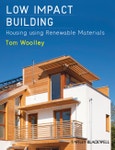This guide to the designs, technologies and materials that really make green buildings work will help architects, specifiers and clients make informed choices, based on reliable technical information.
Low Impact Building: Housing using Renewable Materials is about changing the way we build houses to reduce their ‘carbon’ footprint and to minimise environmental damage. One of the ways this can be done is by reducing the energy and environmental impact of the materials and resources used to construct buildings by choosing alternative products and systems. In particular, we need to recognise the potential for using natural and renewable construction materials as a way to reduce both carbon emissions but also build in a more benign and healthy way. This book is an account of some attempts to introduce this into mainstream house construction and the problems and obstacles that need to be overcome to gain wider acceptance of genuinely environmental construction methods.
The book explores the nature of renewable materials in depth: where do they come from, what are they made of and how do they get into the construction supply chain? The difference between artisan and self-build materials like earth and straw, and more highly processed and manufactured products such as wood fibre insulation boards is explored.
The author then gives an account of the Renewable House Programme in the UK explaining how it came about and how it was funded and managed by Government agencies. He analyses 12 case studies of projects from the Programme, setting out the design and methods of construction, buildability, environmental assessment tools used in the design, performance in terms of energy, air tightness, carbon footprint and post-occupancy issues.
The policy context of energy and sustainability in the UK, Europe and the rest of the world is subjected to a critical examination to show how this affects the use of natural and renewable materials in the market for insulation and other construction materials. The debate over energy usage and embodied energy is discussed, as this is central to the reason why even many environmentally progressive people ignore the case for natural and renewable materials.
The book offers a discussion of building physics and science, considering energy performance, moisture, durability, health and similar issues. A critical evaluation of assessment, accreditation and labelling of materials and green buildings is central to this as well as a review of some of the key research in the field.
Table of Contents
Acknowledgements xFigure credits xi
Introduction xii
The Renewable House Programme xiv
The expansion of natural building xiv
The wider environmental agenda xv
Chapter overview xvii
References xviii
1 Renewable and non-renewable materials 1
Synthetic, manmade materials 2
Limitations of synthetic materials 3
Questioning claims about recycling 4
Resource consumption problem with synthetic materials 7
Renewable materials – insulation 9
Carbon sequestration and embodied energy 10
Performance and Durability of natural materials 11
Natural renewable materials commercially available 11
Low impact materials 22
References 23
2 Case Studies: twelve projects in the Renewable House Programme 26
Abertridwr Y Llaethdy South Wales 29
Drumalla House, Carnlough, County Antrim 35
Blackditch, Stanton Harcourt, Oxfordshire 40
Callowlands, Watford 44
Domary Court, York 49
Inverness 55
Long Meadow, Denmark Lane, Diss 59
LILAC, Leeds 64
Tomorrow’s Garden City, Letchworth 68
Reed Street, South Shields 76
The Triangle, Swindon 80
Pittenweem 88
References 92
3 The Renewable House Programme: a strange procurement! 94
Monitoring and evaluation 103
References 106
4 Analysis of issues arising from the case studies 107
Success in using natural renewable materials 107
Adapting conventional timber frame construction for using natural materials 109
The importance of getting details right and using details appropriate for eco materials 110
Problems with designs and the need to get warranty approvals for changes of details 111
Weather issues and hempcrete 112
Decision of Lime Technology to go for prefabrication in future and whether this is the best option 114
Using wood fibre products and issues related to construction and components 115
References 116
5 Attitudes to renewable materials, energy issues and the policy context 118
Why attitudes and policies affect the use of renewable materials 118
Climate change and energy efficiency targets 118
What is carbon? 119
Sustainable construction and energy policies 120
UK Code for Sustainable Homes 121
New planning policy framework 123
The zero carbon myth 123
The carbon spike concept 125
Energy in use or ‘operational energy’ is all that matters to many 126
How embodied energy was discounted 128
Carbon footprinting 132
Passive design approaches 133
Do natural and renewable materials have lower embodied energy? 133
Carbon sequestration in timber 136
Wood transport issues 137
Carbon sequestration in hemp and hempcrete 138
The Green Deal 139
Official promotion of synthetic insulations 140
Other attitudes hostile to natural materials – the food crops argument 142
Transport and localism 143
Cost 144
References 145
6 Building physics, natural materials and policy issues 148
Holistic design 149
European standards, trade and professional organisations 151
Building physics – lack of good research and education 154
Lack of data and good research on sustainable buildings 155
Energy simulation and calculation tools 157
Assessment of material’s environmental impact and performance 160
Moisture and breathability and thermal mass 164
Breathability 168
Thermal mass and energy performance in buildings 170
Building physics research into hempcrete 174
Indoor air quality 178
References 183
7 Other solutions for low energy housing 187
Hemp lime houses 187
Hemp houses in Ireland 189
Local sheep’s wool in Scotland 192
Strawbale houses in West Grove, Martin, North Kesteven, Lincolnshire 192
Timber experiments 194
Scottish Housing Expo 197
Using local materials? 197
Greenwash projects? 199
So-called ‘carbon neutral’ developments 202
Earth sheltered building 203
BRE Innovation Park 204
Masonry construction for low energy houses 205
Blaming the occupants 209
Back to the 60s and 70s – déjà vu 210
References 211
8 A future for renewable materials? 214
Middlemen 216
Postscript 217
References 219
Glossary/Abbreviations 220
Index 227








